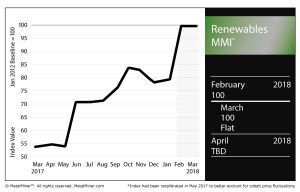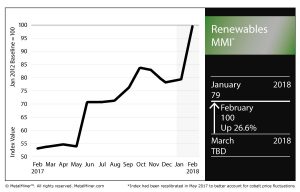[caption id="attachment_88708" align="alignleft" width="300"]
The Renewables MMI (Monthly Metals Index), after a significant surge last month, sat at 100 for the second consecutive month.
Need buying strategies for steel? Try two free months of MetalMiner’s Outlook
Within this basket of metals, the Japanese steel plate price rose, as did the price of Chinese and American steel plate. U.S. steel plate, in fact, rose 5.5% month over month.
U.S. grain-oriented electrical steel (GOES) coil also jumped in price.
As for the trio of rare and minor metals in this MMI, cobalt cathodes fell 1.1%, while silicon dropped slightly and neodymium made a small gain.
Cobalt Costs
According to a report by the Financial Times, changes to the mining code in the Democratic Republic of Congo will lead to higher costs for consumers of the metal.
According to the report, President Joseph Kabila on Wednesday said he would sign a new order after meeting with representatives from some of the big miners with business in the country, including Glencore, Molybdenum and Ivanhoe Mines.
Cobalt is used in batteries for electric vehicles (EVs), among other things, making it an especially prized material as EVs gain popularity. As such, with a majority of the world’s cobalt being mined in the DRC, political machinations in the country have a significant impact on the metal’s price.
According to the Financial Times, the code could see royalties on cobalt — plus other metals, like copper and gold — rise from 2% to 10%.
Senators Lobby for Electrical Steel Protection in 232
The Journal-News reported on a trio of U.S. senators who lobbied Trump to prioritize electrical steel in the Section 232 trade remedy process.
The only remaining maker of electrical steel in the country, AK Steel, was unlikely to benefit from the Section 232 trade remedy proposal, according to Sen. Rob Portman (R-OH).
In the senators’ letter, they requested the president add a trio of HTS codes to the duty order.
MetalMiner’s Annual Outlook provides 2018 buying strategies for carbon steel




